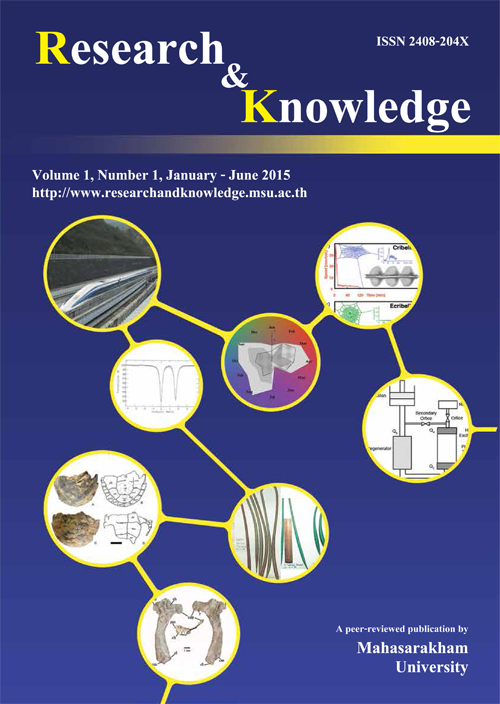Gaps in mangrove science
Keywords:
Mangrove science, gaps, above ground vs ground biomass, salinity tolerance, land building, valuations, bioactive extracts, eco-restorationAbstract
As tidal forest found on tropical and subtropical coastlines, mangroves have long attracted scientists, yet gaps in our knowledge remain. Perhaps refl ecting the many and variable ways in which ecological conditions exist and factors may interact in the intertidal environment, uncertainties and debate are evident at mangrove conferences. Even core issues such as salinity tolerance and what constitutes a ‘true’ mangrove endure. This paper seeks to review the gaps in mangrove science and do so in a way that may stimulate further research. Aspects of mangrove fl ora such as ‘true’ vs. ‘associate’ mangrove and the species concept open the discussion. Some very basic biological processes such as age and wood, phenology and root:shoot biomass allocations follow. These lay the foundations for a survey of ecological processes and challenges including salinity tolerance, soil redox conditions, temperature limitations, propagule dispersal, mineral cycling and mangroves as carbon sinks and land builders. The older topic of mangrove succession and the very neglected question of pathogenic Phytopthora in mangroves are also examined. Collectively, the above biological and ecological gaps in our knowledge provide a platform on which mangrove goods and services and applied sciences can be evaluated. Into these topic areas come the urgently needed economic valuations of mangrove resources in fi sheries and coastal protection, together with their largely unheralded potential as a bank of biomedical and bioactive compounds. Finally, contentious issues such as using (or mis-using) mangroves as sinks for industrial waste and how much biodiversity is needed to maintain functionality in mangrove eco-restoration are examined. Some apparently small but nevertheless attractive topics like tiger and dolphin conservation and mangroves as food also appear and serve to illustrate the sometimes subtle interconnections within mangrove ecosystem science.
References
Abeysinghe, P., Triest, L., De Greaf, B., Kaedam, N. and Hettiarchi, S. 1999. Genetic differentiation between Bruguiera gymnorrhiza and B. sexangula in Sri Lanka. Hydrobiologia 413, 11-16.
Aksornkoae, S., Maxwell, G. S., Havanond, S. and Panichsuko, S. 1992. Plants In Mangroves. Chalongrat Co. Ltd, BKK. Alongi, D. M. 1996. The dynamics of benthic nutrient pool and fl uxes in tropical mangrove forests. J. Mar Res 54, 123-148.
Alongi, D. M. 2009. The Energetics of Mangrove Forests. Springer. Anastasiou, C. and Churchland, L. 1969. Fungi on decaying leaves in marine habitats. Canadian Jl. of Botany 47, 251-257.
Angermeir, P. and Karr, J. 1994. Biological Integrity Versus Biological Diversity as Policy Directives: Protecting Biotic Resources. Bioscience 44, 690-697.
Baba, S. 2011. Close group planting of mangroves on atolls and coral islands of the Pacifi c. ISME/GLOMIS E.Jl. 9 (4), October.
Balasubramaniam, S., Ranawan, K. and Popp, M. 1992. Mineral content and low molecular weight carbohydrates of leafl ets of the mangrove fern, Acrostichum aureum. Aspects of Plant Sciences 14, 445-450.
Ballment, E., Smith, T. and Stoddart, J. 1988. Sibling species in the mangrove genus Ceriops (Rhizophoraceae) detected using biochemical genetics. Aust. Syst. Bot. 1, 325-338.
Barbier, E. 2011. Capitalizing on Nature, Ecosystems as Natural Assets. C.U.P. Bird, E. (1992). Mangroves and coastal morphology in Cairns Bay, Queensland. J. Trop. Geog 35, 11-16.
Boonruang, P. 1978. The degradation of mangrove leaves of Rhizophora apiculata and Avicennia marina at Phuket Island, Thailand. Puket Marine Bioloical Centre, Research Bulletin 24, 1-7.
Boto, K.G. 1991. Nutrients and mangroves. In: Connell, D.W. & Hawker, D.W. (Eds). Pollution in tropical aquatic systems, pp 129-145. CRC Press,
Boca Raton, FL. Bowman, H. 1917. Ecology and physiology of the red mangrove. Proc. Amer. Phil. Soc 56, 589-672.
Bradshore, A. 1990. Restoration: and acid test for ecology. In: Jordon, W., Gilpin, M. and Aber, J. Restoration Ecology, C.U.P.
Bush, M. B. 2003. Ecology of a Changing Planet (Third Edition). Prentice Hall.
Chan, E., Fong, C., Kang, K. and Chong, H. 2012. Potent antibacterial activity of wood vinegar from Matang mangrove, Malaysia. ISME/GLOMIS E. Jl. Vol 10, No.7, October.
Chan, H.T. 2014. Some topics of research interest in the Matang Working Plan. ISME/GLOMIS E. Jl. vol. 12(2), March.
Chapman, V. J. 1976. Mangrove Vegetation. J.
Cramer Pub. Clark, J. 1996. Disturbance and Population structure on the Shifting Mosaic Landscape. Ecology 72: 1119- 1137.
Clough, B., Ong, J. and Gong, W. 1997. Estimating leaf area index and photosynthetic production in canopies of the mangrove Rhizophora apiculata. Mar Ecol Prog Ser 159, 285-292.
Clough, B. F. 1992. Primary productivity and growth of mangrove forests. In: Robertson A.I. & Aongi, D.M. (Eds). Tropical Mangrove ecosystems, pp 225-249. American Geophysical Union, Washington, D.C.
Cocheret de la Morinere E., Nagelkerken, I. van der Meiji H. and van der Velde, G. 2004. What attracts juvenile fi sh to mangroves: Habitat complexity or shade? Mar Biol 144, 139-145.
Curran, M.M Code, M. and Allaway, W. 1986. Root aeration and respiration in mangrove plants [Avicennia marina] J. Exptl. Bot 37(181), 1225-1233.
Dixon, R. 1959. A working plan for the Matang Mangrove Forest Reserve, Perak Forest Dept., Perak, Federation of Malaya.
Dromgoole, F. 1988. Carbon dioxide fi xation in aerial roots of the New Zealand mangrove, Avicennia marina var. resinifera NZ J. Mar. Freshw. Res 49, 329-334.
Duke, N. 1995. Genetic diversity, distributional barriers and rafting continents – more thoughts on the evolution of mangroves. Hydrobiologia 295, 167-181.
Duke, N. and Khan, M. 1999. Structure and composition of the seaward mangrove forest at Mai Po Marshes Nature Reserve, Hong Kong. In: The Mangrove Ecosystem at Deep Bay, Hong Kong Ed by Lee, S.Y. H.K. Univ. Press.
Field, C. D. 1995. Journey amongst mangroves: International Society for Mangrove Ecosystems (ISME) ITTO, Okinawa, Japan.
Fujimoto, K., Miyagi, T., Kikuchi, T. and Kawana, T. 1996. Mangrove Habitat Formation and Response to Holocene Sea-level Changes on Kosrae Island, Micronesia. Mangroves and Salt Marshes 1, 47-57.
Gill, A.M. 1971. Endogenous control of growth-ring development in Avicennia F. Sci 17, 462-65.
Glugston, M. J. 2009. Dictionary of Science. Penguin Reference Books.
Gray, L., Shubin, K., Cummins, H., Mc Collum ,D., Bruns ,T and Comiskey ,E. 2010. Sacrifi cial leaf hypothesis of mangroves. ISME/ GLOMIS E. Jl. vol. 8 ( 4), April.
Havanond, S. 2000. Effects of Mud Lobster on Mangrove Succession in Thailand. PhD Thesis, Tokyo University of Agriculture. 250pp.
Havanond, S. and Maxwell, G. S. 2005. The Thai tsunami: lessons for New Zealand. Paper, Paeroa Rotary, Waikato, New Zealand.
Havanond, S., Maxwell, G. S., Piriyayotha, S. and Chaiyasit, T. 1996. Strategies in Mangrove restoration. Trop. For. in 21st Century Vol. 10. pp 36- 56 FORTROP ’96. Bangkok, Thailand.
Hiraishi, T., and Harada, K. 2003. Greenbelt tsunami prevention in South Pacific region. Rep Port Airport Res. Inst 42, 1-23.
Hodgkiss, I. J. 1986. Aspects of mangrove ecology in Hong Kong. Mem. H.K. Nat. Hist. Soc., 17: 107-116.
Hodgkiss, I. J. 1997. Life on the fringes: the biology of mangroves and the role they play in Hong Kong. Jl. Hong Kong Branch of Roy. Asiatic Soc. 35, 155-169.
Homhual, S., Bunyapraphatsara, N., Chuakul, W. and Aksornkoae, S. 2004. Isolation of anti-oxidant from Bruguiera gymnorrhiza. In: IMMPDCR, Integrated Management of Mangrove Plantations for Development of Thailand (Thai Envir. Institute), pp 221-228.
Hon, Pui-Man, E. 2004. The Ecological status of Acrostichum aureum, A Mangrove fern, in Hong Kong. BSc (Hons) (1st class & President Medal) Thesis 100pp OUHK.
Hong, P. N. and Hoang, T. S. 1993. Mangroves of Vietnam. IUCN. Hong, P. N. and Tuan, M. S. 1981. The role of Avicennia genus in the economy. Jl. of Biology No.4 (Hanoi): 1-5 (in Vietnamese).
Huang, S. and Chen, Y-H. 1996. The Genetic Differentiation in Kandelia candel along Ryukyu Archipelago and Taiwan. In: Tropical Forestry in the 21st Century. Vol. 10: Mangrove Ecosystems. Fortrop ’96, Intl. Conference 25-28 Nov. BKK, pp 1-11
Husband, B. 2005. Practical Pollination Biology. Enviroquest, Cambridge. Hutchings, P. and Saenger, P. 1987. Ecology of Mangroves. Queensland Univ. Press.
Hyde, K.D. 2002. Fungi in Marine Environments. Fungal Diversity Press. ISBN 962-85677-8-0. IUCN. 2012. IUCN Red List of Threatened Species, Version 2012 (accessed 1.4.2014).
Jansen, D. H. 1985. Mangroves: where is the understory? J. Trop Ecol 1, 89-92.
Jones, C., Lawton, J. and Shachak, M. 1994. Organisms as Ecosystems Engineers. Oikos 69, 373-386.
Kamruzzaman, M., Sharma, S., Kamara, M. and Hagihara, A. 2013. Phenological traits of the mangrove Rhizophora stylosa at the northern limit of its biogeographical distribution. Wetlands Eco Manage 21, 277-288.
Kathiresan, K. 1995. Rhizophora annamalayana: a new species of mangrove. Environment and Ecology 13, 240-241.
Kathiresan, K. 2010. Unique features of mangrove ecosystems in India ISME/ GLOMIS E. Jl. Vol: 8(5), May. Kathiresan, K. and Thangam, T. 1989. Effect of leachates from mangrove leaf on rooting in Rhizophora seedlings. Geobios 16, 27-29.
Kitmaura, S., Anwar, C., Changiago, A. and Baba, S. 1997. Handbook of Mangroves in Indonesia. JICA ISME c/o University of Ryukyus, Okinawa.
Komiyama, A., Ogion, K., Aksornkoae, S. and Sabhasri, S. 1987. Root biomass of a mangrove forest in Southern Thailand. I. Estimation by the trench method and zonal structure of root biomass. J. Trop. Ecol. 3, 97- 108.
Lacerda, L., Machado, W. and Moscatelli, M. 2000. Use of mangroves in landfi ll management. ISME/GLOMIS E. Jl. Vol (1), March.
Leung, H. C. 1986. Aspects of leaf litter decomposition in Kandelia candel. M. Phil Thesis, Univ. Hong Kong.
Li, M. S. 1997. Nutrient dynamics of a Futian mangrove forest in Shenzhen, south China. Est Coast Shelf Sci 45, 463-472.
Lin, P. 1999. Mangrove ecosystems in China. Science Press, Beijing.
Lopez-Pertillo J. and Ezurra, E. 1989. Response of three mangroves to salinity in two geoforms. Functional Ecology 3, 355-361.
MacFarlane, G. R. & Burchett, M. D. 2002. Cellular distribution of copper, lead and zinc in the grey mangrove, Avicennia marina. Aqu. Bot. 68, 45-59.
Machado, W., Tanizaki, K., and Lacerda, L. 2004. Metal accumulation on the fi ne roots of Rhizophora mangle. ISME / GLOMIS E. Jl. vol 4 (1), April.
Macintosh, D. J., Ashton, E. C., Clough, B., Hogarth, P., Kjerfve, B., Nielsen, T., Schmitt, K., Foong, S., Ong J-E., Fortes, M. D., Yong, J., Bamroongrugs, N., Tantichodol, P., Tuan, M., Havanond, S., Apiwan, K. and Maxwell, G. S. 2013. Transboundary Diagnostic Analysis of Indochina Mangrove Ecosystems, Project Final Report, SIDA/SIEPE (Swedish International Cooperation Agency/Sirindhorn Inter-national Environmental Park Founcation).
Macnae, W. 1968. A general account of the fauna and fl ora of mangrove swamps and forests in the Indowest Pacifi c region. ADV. Mar. Biol. 6, 73-270.
Maxwell, G. S. and Li, S. W. 2006. Barnacle infestation on the bark of Kandelia candel and Aegiceras corniculatum. ISME/GLOMIS E. Jl. Vol. 5. No.2, November.
Maxwell, G. S. 1968. Pathogencity and salinity tolerance of Phytophthora sp. Isolated from Avicennia resinifera. Tane 14, 13-23.
Maxwell, G. S. 1971. A Phytophthora sp in mangrove communities at Piako, New Zealand. MSc (Hons) Thesis, The University of Auckand.
Maxwell, G. S. 1976. The economic importance of New Zealand mangroves. Nature Conservation Council, Wellington, N.Z.
Maxwell, G. S. 1984. The Okahuiti mangrove ecosystem, Waiheke Island. Report for Waiheke County Council, 8pp.
Maxwell, G. S. 1991. Perspectives on mangrove management: lessons from Brunei, Hong Kong and Thailand. Malaysian Jl. of Trop. Geog. 22 (1), 29-36.
Maxwell, G. S. 1993. Ecogeographic studies of Avicennia marina and Kandelia candel in Brunei Hong Kong and Thailand. PhD Thesis, Univ. of Hong Kong, 400pp.
Maxwell, G.S. 1995. Mangrove mitigation in Hong Kong. Proc. Ecotone IV, Surat Thai, Thailand, 307-315.
Maxwell, G. S. 2000. Mangroves as land builders, Hong Kong Geologist 6: 20-28.
Maxwell, G. S. 2002. Chill shock tolerance differentiates Hong Kong and Thai ecotypes of Avicennia marina. Mangrove Science. 2, 43-45.
Maxwell, G.S. 2002. The Mangrove fern: associate or true mangrove Mem. H.K. Nat. Hist Soc. 25, 117-121.
Maxwell, G. S. 2006. In Winds from Hell…escape to the Mangroves Coastal News. Newsletter of the New Zealand Coastal Society: a Technical Group of Institute of Professional Engineers NZ Issue 33, November: 13-14.
Maxwell, G. S. 2007. Kandelia candel and Kandelia obovata: ecotypes, varieties or different species? Mangrove Science 4.5, 31-40.
Maxwell, G. S. and Havanond, S. 1991. Field Inspection and Aquatic Reconnaissance of Sungui Pemburongunan and Sungui Tutong in Brunei Darussalam, March 10-12. Report for Regional Forest Offi ce, R.F.D., Nakhorn Si Thammarat, Thailand.
Maxwell, G. S. and Lai, C. 2012. Avicennia marina foliage as salt enrichment nutrient for New Zealand dairy cattle. ISME/GLOMIS E. Jl. Vol 10(8).
Maxwell, G. S. and Lai, C. 2012. Can the Irrawaddy Dolphins (ID) be a fl agship iconic species for TBDA Workshop Indo-Malay Eco-Region Trans Boundary Diagnostic Analysis Workshop (2), Sept., Cha-Am, Thailand.
Mazda, Y., Magi, M., Kogo, M. & Hong, P.N. 1997. Mangroves as coastal protection from waves in the Tong King delta, Vietnam. Mangr Salt March 1, 127-135.
Medina, E., Cueras, E., Popp, M. and Lugo, A. E. 1990. Soil salinity, sun exposure and growth of Acrostichum aureum, the mangrove fern. Bot Gaz. 151, 41-450.
Mude, D. and Mustafa, N. 2003. A working plan for the Matang mangrove forest reserve, Perak, State Forestry Dept. Perak, Ipoh, Malaysia.
Nadia, T. and Machado, I. 2014. Inter-population variation in sexual and pollination systems of two Combretaceae spp in Brazilian mangrove. Aqu, Bot 114, 35-41.
Naeem, S., Bunker, D., Hector, A., Loreau, M. and Perrings, C. 2009. Biodiversity, Ecosystem Functioning, and Human Wellbeing, An Ecological and Economic Perspective. Oxford U.P.
Nakagiri, A. 2002. Halophtophthora species from tropical and subtropical mangroves: A review of their characteristics. In: Hyde K.D. (Ed), pp 1-14.
Nakamura, T. 1997. pers comm at Tokyo University of Agriculture Expedition to Iriomote Island, Okinawa, October.
Naskar, S. and Palit, P. 2014. Aanatomical and physiological adaptations of mangroves. Wetlands Ecol Mange. Online 23 Sept. 2014.
Ong, J. 1982. Mangroves and aquaculture in Malaysia. Ambio 11, 252-257.
Pananitkkul, N., Durate, C., Thampanya, U., et al. 1998. Mangrove colonization: mangrove progression over the growing Pak Phanang (S.E. Thailand) mud fl at. Estuarine Coastal and Shelf Science 47, 51-61.
Parani, M. et al. 1997. Molecular phylogeny of mangroves III. Parentage analysis of a Rhizophora hybrid. Aqu. Bot. 58, 165-172.
Parani, M., Lakshii, M., Senthilkumar, P., Ram, N. and Parida, A. 1998. Molecular phylogeny of mangroves. This PDF document was edited with Icecream PDF Editor. V. Analysis of genome relationships in mangrove species using RAPD and RFLP markers. Theor. Appl. Genet. 97, 617-625.
Pegg, K., Gillespie, N. and Forsberg, L. 1980. Phytophthora sp. associated with mangrove death in central coastal Queensland. Aust. Plant Path. 9(3), 6-7.
Pinto, L. 1987, Environmental factors infl uencing the occurrence of juvenile fi sh in the mangroves of Pagbilae, Philippines. Hydrobiologia 150, 283-301.
Primavera, J. 2014. Ecohydrology email exchange group of mangrove scientists, pers comm. (Based in Philippines and a response group to frequent typhoons).
Primavera, J. Sadaba, R., Lebata, M. and Altamirano, J. 2004. Handbook of Mangroves in the Philippines – Panay. SEAFDC & UNESCO, Iliolo. Philippines. 106pp.
Risser, P. 1991. Biodiversity and Ecosystem Function. Conservation Biology 9, 742-746.
Rodrigues, D., Hamacher, C., Estrada, G and Soares, M. 2014. Variability in Carbon content in mangrove species: effect of species, compartments and tidal frequency. Aqu. Bot. 120, 346-351.
Rovai, A. Edardo, J., Paliosa, P. et al 2012. Secondary Succession impairment in restored mangroves. Wetlands Ecol Manage 20, 447-459.
Saenger, P. 2002. Mangrove Ecology, Silviculture and Conservation. Kluwer Academic Publishers.
Sanchirico, J. and Mumby, P. 2009. Mapping ecosystem function to the valuation of ecosystem services: implications of species – habitat associations for coastal land-use decisions. Theoretical Ecology 2, 67-77.
Smith, A.H. and Berker, F.1993. Community-based use of mangrove resources in St. Lucia, Intern. J. Envir. Studies 43, 123-131.
Smith, A.H. and Berkes, F. 1993. Community-based use of mangrove resources in St. Lucia. Intern. J. Envir. Studies 43, 123-131.
Smith, R. and Smith, T. 2000. Elements of Ecology. Benjamin Cummings.
Smith, T., Braford, M. and Wayne, R. 1993. The Preservation of Process: The Missing Element of Conservation Programs. Biodiversity Letters 1, 164-167.
Snedaker, S. C. and Lahmann, E. J. 1988. Mangrove understory absence: a consequence of evolution? J. Trop. Ecol. 4, 311-314.
Tam, N. and Wong, Y. 2000. Hong Kong Mangroves AFCD and City Univ. of Hong Kong Press.
Tam, N. F. and Wong, Y. S. 1997. Accumulation and distribution of heavy metals in a simulated mangrove system treated with sewage. Hydrobiologia 352, 67- 75.
TDA-IME Project. 2013. Indochina Mangrove Ecosystems, Final Report, SIDA/FIEPE.
Teh, T. and Lim, C. 1993. Impacts of sea-level rise on mangroves of Peninsula Malaysia. Malaysian J. Trop Geog. 24 (1/2), 57-72.
Thangam, T. and Kathiersan, K. 1992. Mosquito larvicidal activity of mangrove plant extract against Aedes aegypti. Intl. Pest Control 34(4), 116-119.
Tomlinson, P. B. 1986. The Botany of Mangroves. Camb. U. Press. 413pp.
Watson, J. 1928. Mangrove forests of the Malay Peninsula. Malayan For. Rec. 6, 1-75.
Wee, A. K. S., Low, S. Y. and Webb, E. L. 2014. Pollen limitation affects reproductive outcome in the birdpollinated mangrove Bruguiera gymnorrhiza Aqu. Bot. 120 (Pt. B), 240-243.
Wong, Y. S., Tam, N .F. and Lam, C. Y. 1997. Mangrove wetlands as wastewater treatment facility: a fi eld trial. Hydrobiologia 352, 49-59.
Young, B. and Harvey, L. 1996. A Spatial Analysis of the Relationship between mangrove (Avicennia marina var. australasica) physiogony and sediment accretion in the Hauraki Plain, N.Z. Estuarine, Coastal and Shelf Sci) 42, 231-246.
Downloads
Published
How to Cite
Issue
Section
License

This work is licensed under a Creative Commons Attribution-NoDerivatives 4.0 International License.







